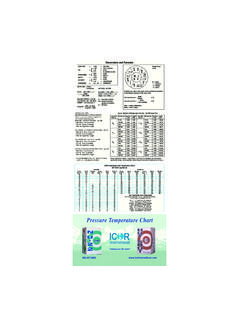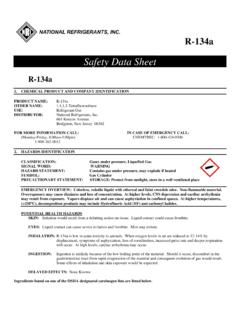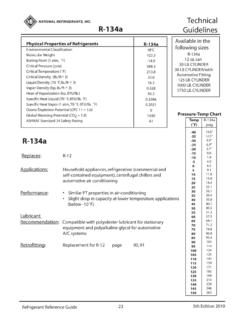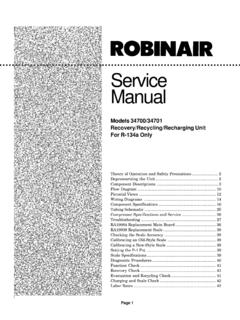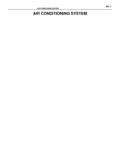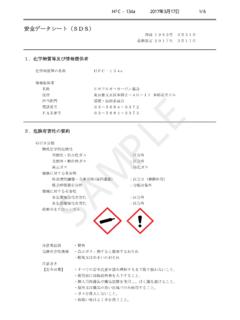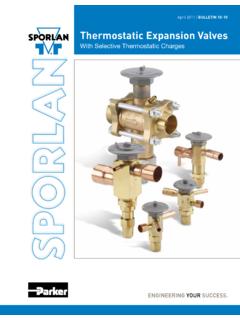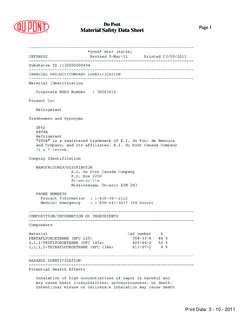Transcription of Forane(R) 134a Material Safety Data Sheet - Chiller City
1 1 Page of Product Code:04134 Revision: 1008 NOV 2004 Issued:6 Material Safety Data SheetPRODUCT AND COMPANY IDENTIFICATION1 EMERGENCY PHONE NUMBERS:Chemtrec: (800) 424-9300 (24hrs) or (703) 527-3887 Medical: Rocky Mountain Poison Control Center (866) 767-5089 (24 Hrs) Product InformationInformation Telephone Numbers800-245-5858 Phone Number8:00 am - 5:30 pm (Eastern)Available HrsIngredient NameCAS RegistryNumberTypical Wt. %OSHA 2 COMPOSITION / INFORMATION ON INGREDIENTSThe substance(s) marked with a "Y" in the OSHA column, are identified as hazardous chemicals according to thecriteria of the OSHA Hazard Communication Standard (29 CFR )The components of this product are all on the TSCA Inventory IDENTIFICATIONA rkema (R) 134aEmergency OverviewPotential Health EffectsClear, colorless liquified gas with faint etheral (ether like) odor.
2 WARNING! LIQUID AND GAS UNDER PRESSURE, OVERHEATING AND OVERPRESSURIZING MAY CAUSE GAS RELEASE OR VIOLENT CYLINDER BURSTING. MAY DECOMPOSE ON CONTACT WITH FLAMES OR EXTREMELY HOT METAL SURFACES TO PRODUCE TOXIC AND CORROSIVE PRODUCTS. VAPOR REDUCES OXYGEN AVAILABLE FOR BREATHING AND IS HEAVIER THAN AIR. HARMFUL IF INHALED AND MAY CAUSE HEART IRREGULARITIES, UNCONSCIOUSNESS OR DEATH. LIQUID CONTACT WITH EYES OR SKIN MAY CAUSE FROSTBITE. Skin contact and inhalation are expected to be the primary routes of occupational exposure to this Material . As with most liquefied gases, contact with the rapidly volatilizing liquid can cause frostbite to any tissue.
3 High vapor concentrations are irritating to the eyes and respiratory tract and may result in central nervous system (CNS) effects such as headache, dizziness, drowsiness and, in severe exposure, loss of consciousness and death. The dense vaporof this Material may reduce the available oxygen for breathing. Prolonged exposure to an oxygen-deficient atmosphereDFO2000 Market StreetPhiladelphia, PA 19103 Forane(R) 134aProduct NameA list of applicable products can be found in Section 16R- 134a , HFC-134aProduct Synonym(s)hydrofluorocarbonChemical FamilyCH2 FCF3 Chemical Formula1,1,1,2-tetrafluoroethaneEPA Reg NumRefrigerant, foam blowing agent, aerosol propellantProduct UseChemical Name100%Y1,1,1,2-tetrafluoroethane (HFC- 134a )811-97-2 This Material is classified as hazardous under Federal OSHA of Product Code:04134 Revision: 1008 NOV 2004 Issued.
4 6 Material Safety Data Sheet4 FIRST AID MEASURESIF IN EYES, immediately flush with plenty of water. Get medical attention if irritation ON SKIN, Flush exposed skin with lukewarm water (not hot), or use other means to warm skin slowly. Get medical attention if frostbitten by liquid or if irritation SWALLOWED, Not applicable - product is a gas at ambient INHALED, remove to fresh air. If not breathing, give artificial respiration. If breathing is difficult, give oxygen. Get medical attention. Do not give adrenaline, epinephrin or similar drugs following exposure to this product.
5 5 FIRE FIGHTING MEASURES743 CAuto-Ignition TemperatureNA - GASF lash PointFlash Point MethodNONEF lammable Limits- UpperNONEL owerExtinguishing MediaFire Fighting InstructionsFire and Explosion Hazards Use extinguishing media appropriate to surrounding fire conditions. Stop the flow of gas if possible. Use water spray on person making shut-off. Fire fighters and others who may be exposed to products of combustion should wear full fire fighting turn out gear (full Bunker Gear) and self-contained breathing apparatus (pressure demand NIOSH approved or equivalent).
6 Fire fighting equipment should be thoroughly decontaminated after use. May decompose on contact with flames or extremely hot metal surfaces to produce toxic and corrosive products. Liquid and gas under pressure, overheating or overpressurizing may cause gas release and/or violent cylinder bursting. Container may explode if heated due to resulting pressure rise. Some mixtures of HCFCs and/or HFCs, and air or oxygen may be combustible if pressurized and exposed to extreme heat or (R) 134aFire and Explosive Propertiesmay be fatal. Inhalation may cause an increase in the sensitivity of the heart to adrenaline, which could result in irregular or rapid heartbeats.
7 Medical conditions aggravated by exposure to this Material include heart disease or compromised heart RELEASE MEASURESHANDLING AND STORAGEIn Case of Spill or LeakHandling Use Halogen leak detector or other suitable means to locate leaks or check atmosphere. Keep upwind. Evacuate enclosed spaces and disperse gas with floor-level forced-air ventilation. Exhaust vapors outdoors. Do not smoke or operate internal combustion engines. Remove flames and heating elements. Avoid breathing gas. Avoid contact with eyes, skin and clothing. Keep container closed. Use only with adequate ventilation.
8 Do not enter confined spaces unless adequately ventilated. 3 Page of Product Code:04134 Revision: 1008 NOV 2004 Issued:6 Material Safety Data SheetArkema (R) 134a1,1,1,2-tetrafluoroethane (HFC- 134a )WEEL TWAE xposure Limit-1000 ppm 4240 mg/m3 ValueAirborne Exposure Guidelines for Ingredients -Only those components with exposure limits are printed in this contact limits designated with a "Y" above have skin contact effect. Air sampling alone is insufficient to accurately quantitate exposure. Measures to prevent significant cutaneous absorption may be Sensitizer designator with a value of "Y" above means that exposure to this Material may cause allergic Sensitizer designator with a value of "Y" above means that exposure to this Material may cause allergic skin AND STORAGEEXPOSURE CONTROLS / PERSONAL PROTECTIONS torageEngineering ControlsEye / Face ProtectionSkin ProtectionRespiratory Protection Do not apply direct flame to cylinder.
9 Do not store cylinder in direct sun or expose it to heat above 120 F. Do not drop or refill this cylinder. Keep away from heat, sparks and flames. Investigate engineering techniques to reduce exposures below airborne exposure limits. Provide ventilation if necessary to control exposure levels below airborne exposure limits (see below). If practical, use local mechanical exhaust ventilation at sources of air contamination such as open process equipment. Where there is potential for eye contact, wear chemical goggles and have eye flushing equipment available. Wear appropriate chemical resistant protective clothing and chemical resistant gloves to prevent skin contact.
10 Consult glove manufacturer to determine appropriate type glove Material for given application. Rinse contaminated skin promptly. Wash contaminated clothing and clean protective equipment before reuse. Wash skin thoroughly after handling. Avoid breathing gas. When airborne exposure limits are exceeded (see below), use NIOSH approved respiratory protection equipment appropriate to the Material and/or its components (full facepiece recommended). Consult respirator manufacturer to determine appropriate type equipment for a given application. Observe respirator use limitations specified by NIOSH or the manufacturer.
